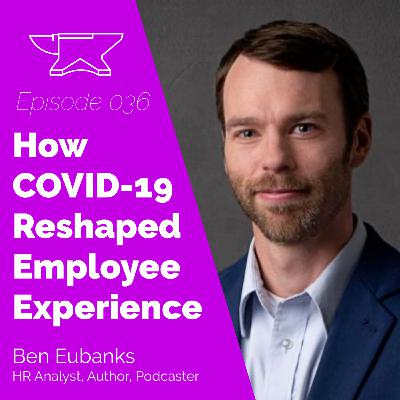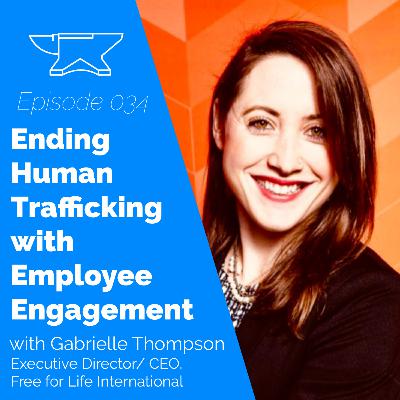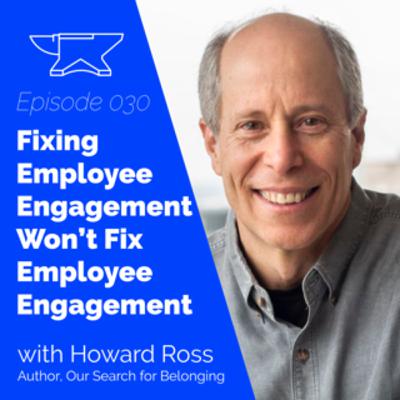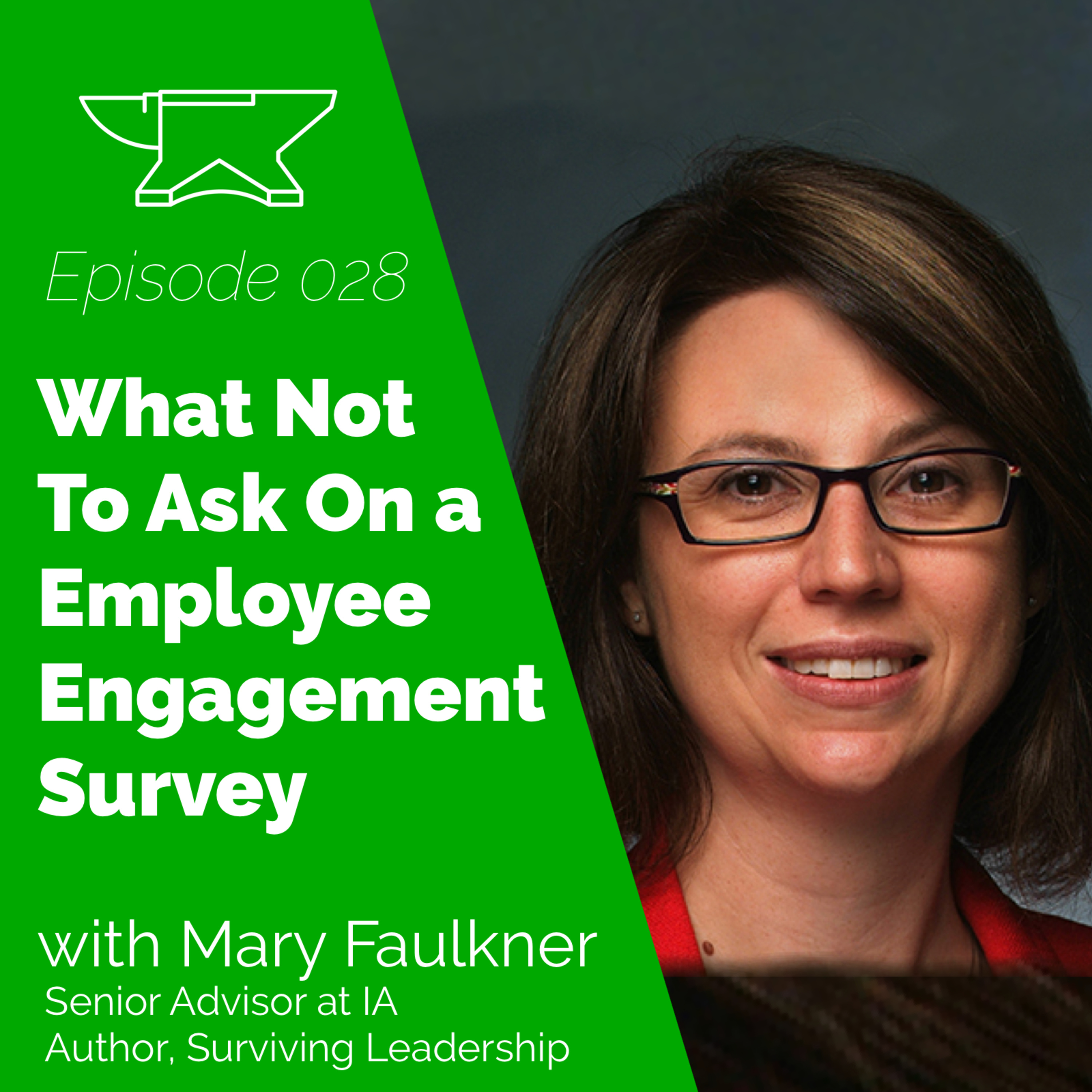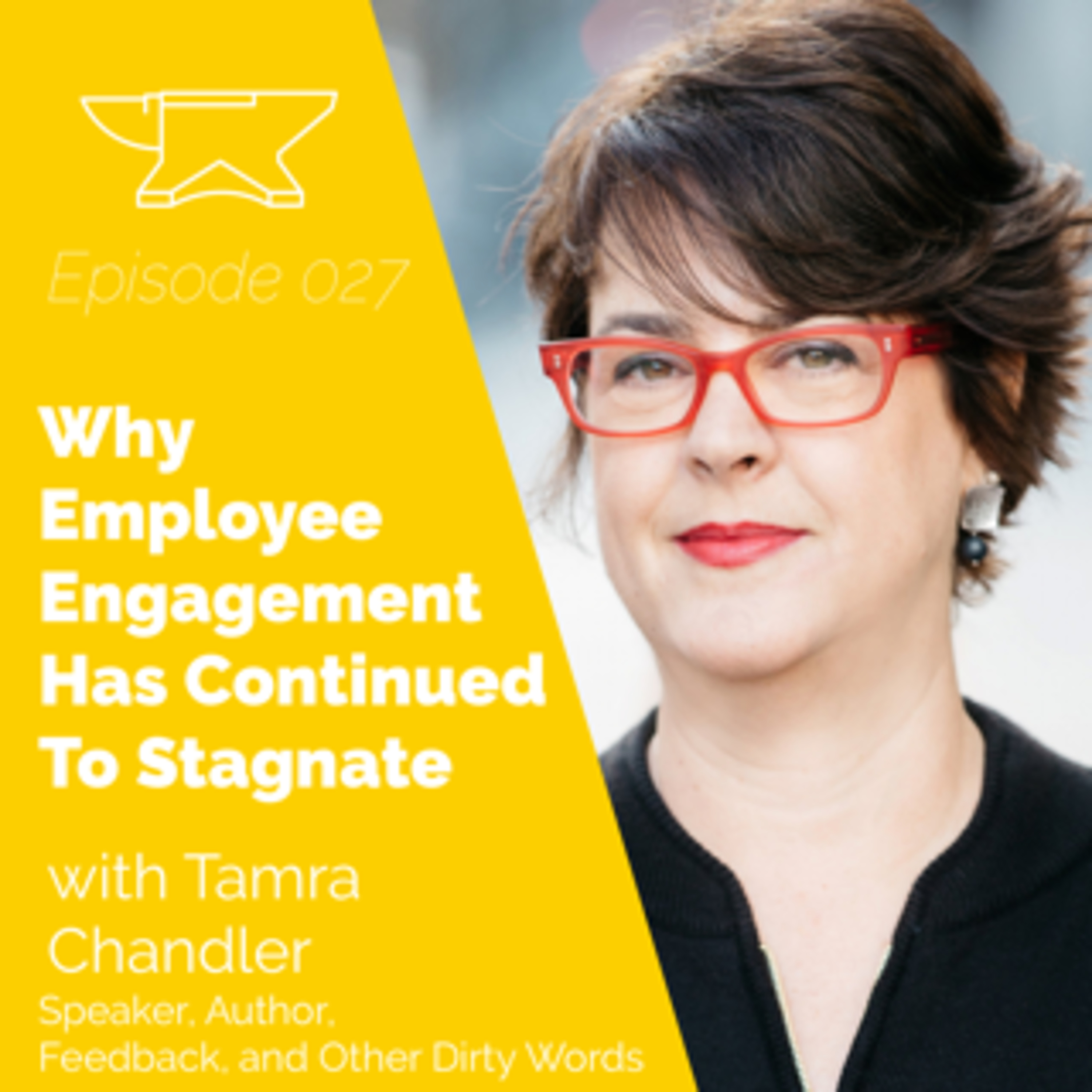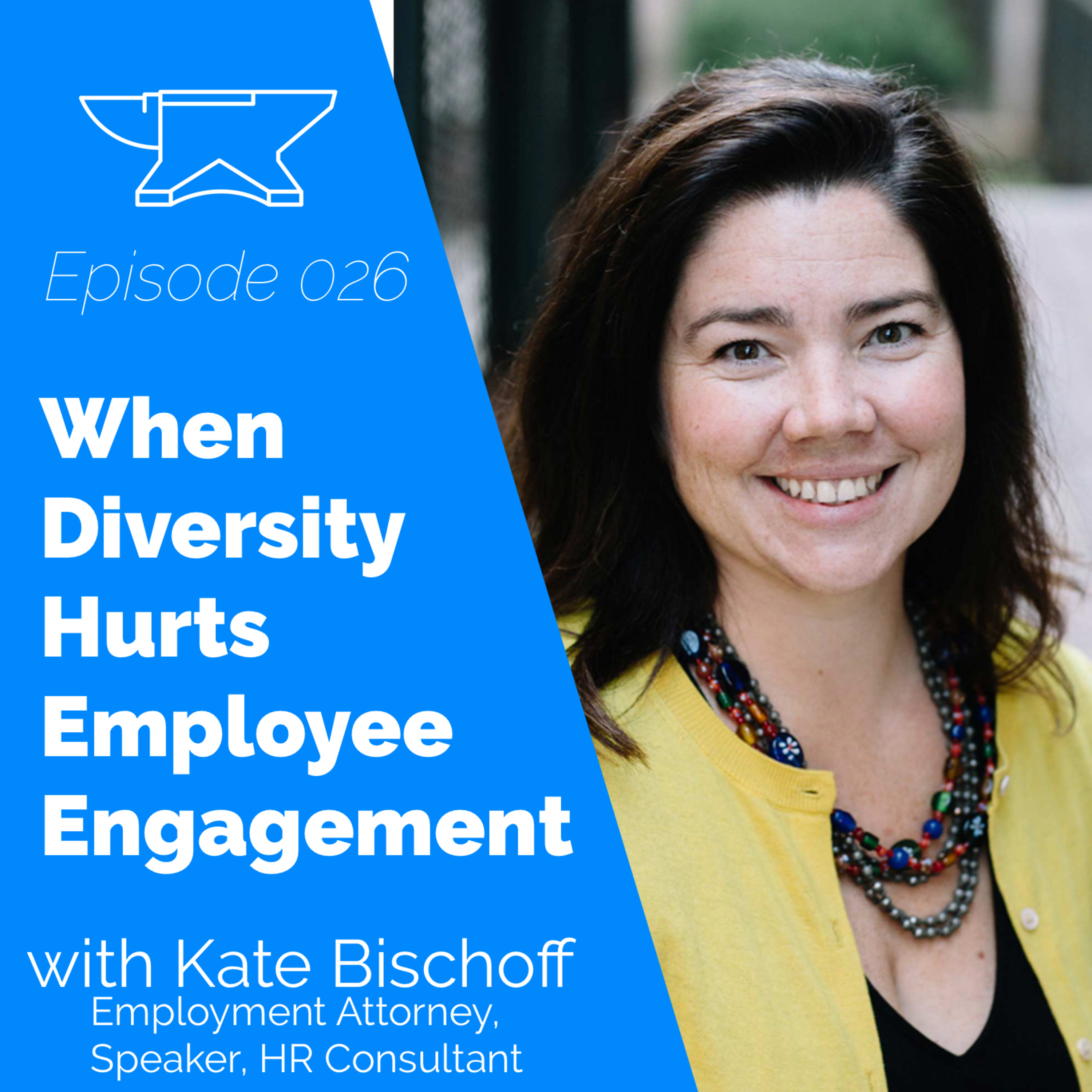Discover Forging Employee Experience
Forging Employee Experience

Forging Employee Experience
Author: Blaze Performance
Subscribed: 18Played: 170Subscribe
Share
© Blaze Performance
Description
Employee engagement is dead. Employee Experience in a traditional office is dead. If you, like all leaders post COVID-19, need to make split decisions that drive the best digital employee experience (DEX), this podcast delivers on all the latest and greatest strategies that top companies are implementing today.
Join our host, David Williams, as he helps you to retain your top talent during these challenging times.
www.forgeant.com Support this podcast: https://podcasters.spotify.com/pod/show/blazeperformance/support
Join our host, David Williams, as he helps you to retain your top talent during these challenging times.
www.forgeant.com Support this podcast: https://podcasters.spotify.com/pod/show/blazeperformance/support
54 Episodes
Reverse
On any given normal workday, we see our employees come into the office and go about their work. Their mere presence at work tells us a lot more than we think.
If an employee shows up at work, then they are not too sick to get out of bed, at the hospital, taking care of their children, or caring for other loved ones. We can also assume that nothing overly drastic has happened in their life such that they would need to be somewhere else. We can further deduce from their appearance and behavior, compared to their normal, if they are stressed or agitated. (Thanks Watson)
That is a lot of assumptions that we typically have unlimited access to when working alongside coworkers.
Covid-19 has taken most of that away from us.
We have no idea what is going on with our employees. We know they are getting their work done because they respond to emails, take conference calls, and meet deadlines. But all of the external factors that affect their mental state are a complete mystery.
Are their family members healthy? Are their kids driving them crazy? Are they short on hard-to-find supplies (why is all the toilet paper gone?!)? Do they personally feel under the weather? Are they supported with the technology they need to do their job? Are they agitated at all the information they’re being bombarded with?
These are just some of the things that are definitely affecting the workforce of today. In a recent podcast with Ben Eubanks, HR Analyst, Author, and Podcaster, he describes the fundamental attributes that organizations must have as they work with their new logistic set up – grace. Ben describes the attitude of grace as one of compassion and understanding. While we don’t necessarily know all of the things that are going on in our employees’ lives, we do know that there are now a lot of unknowns. Being truly empathetic of that and treating our employees accordingly is the true meaning of grace. To hear the rest of the podcast go to Forging Employee Experience. To connect with Ben, go to his site: https://lhra.io/.
Employees and employers alike are having a tough time with so many things that have nothing to do with their day-to-day responsibilities. Now more than ever, employers need to listen and hear what is going on with their at-home workforce to better lead and assist them through the tough times ahead.
---
Support this podcast: https://podcasters.spotify.com/pod/show/blazeperformance/support
Josh and Alexander recap the amazing content Dr. Tomas shared on his recent episode. Come learn from the best and brightest minds of this generation as it relates to the future of work and designing a better employee experience.
For more info visit Dr. Tomas' website: https://drtomas.com/
---
Support this podcast: https://podcasters.spotify.com/pod/show/blazeperformance/support
Managers hold power. They have the ability to control and regulate the daily life of an employee. Their administrative mandate to observe, review, and divvy out work implicitly gives them the ability to determine how and when an employee works. Furthermore, the human condition subconsciously leads us to believe that those with such authoritative responsibility should be trusted more than those without.
This leads to a power dynamic. Every employee knows that their boss could make their life miserable. Furthermore, every employee knows that in the event of a dispute, the company is likely to take the side of the boss. This is especially true in workplaces where management consists of a very non-diverse group of people.
This power dynamic is the fundamental reason why confidence is so often viewed as competence. In a recent podcast, with Dr Tomas Chamorro-Premuzic, Professor of Business Psychology at Columbia University & UCL, we explored the notion that a fundamental problem with the nature of work today is promotions. Instead of promoting the person who is going to best lead the team, the person with the most confidence gets promoted. To listen to the rest of the podcast, visit Forging the Employee Experience. To connect with Dr Chamorro-Premuzic visit him on LinkedIn or visit his website.
This practice is a recipe for poor employee experience. When people work for bosses they don’t like, they start working just for the paycheck. No one should have to work just because they want the paycheck. Everyone should be able to work in a place where they can feel like they are contributing meaningfully to the work being done.
When we prioritize confidence over competence, we undermine the integrity of the work ecosystem by telling our employees that their performance is less important than their personality … which, by the way, wasn’t good enough to get them that promotion.
Entry- and mid-level managers have the absolute greatest influence on an organization’s culture and each employee’s experience at work. The system is set up for failure if the wrong people get promoted into positions of authority. Instead, we need to ensure that competence and leadership are the prevailing characteristics of the next wave of managers.
---
Support this podcast: https://podcasters.spotify.com/pod/show/blazeperformance/support
As far as titles go, the above might be slightly melodramatic. Nevertheless, it’s one hundred percent valid.
In a recent podcast with Gabrielle Thompson, CEO of Free for Life International, we had the opportunity to discuss how her organization’s mission is the identification, assistance, and restoration of victims and survivors of human trafficking. (Before we get any further into this article, please consider making a donation at their website.) No one would argue that their goal is an ambitious and noble one. It’s also a very difficult, multifaceted plight to tackle. There are several different areas of focus that could be leveraged in order to make progress, but all of them share a central, common resource – they all require people to get it done.
On the spectrum of types employees an organization like Free for Life would want to aide them in their mission to end human trafficking, they don’t want people showing up just for a paycheck. Too many organizations settle for employees who are just there to get paid. Worse yet, by and large, it’s the fault of the organization.
Free for Life has a very strong and clear mission. Because of the strength and clarity of that mission, they know exactly what they are looking for when they hire new people. They’re looking for candidates who share that same passion for freedom. This simple onboarding lens allows Free for Life to make sure that they are not hiring the wrong type of people into their organization.
Thousands of people have been rescued through the efforts of Free for Life. These rescues did not occur because of a group of employees who are apathetic about the overall success of the company.
Freedom happened because their employees are engaged.
Most organizations don’t have the same caliber of cause to rally behind but that doesn’t mean that don’t have any cause at all. If companies want passionate, engaged employees, then they themselves need to be passionate and engaged in a clear, understandable mission.
To hear more about how Free for Life uses their powerful mission to engage its employees, please visit Forging Employee Experience. If you’d like to connect with Gabrielle and hear more about the work they are doing reach, out to them at https://freeforlifeintl.org/contact-us/.
Once again, please consider donating via their website.
---
Support this podcast: https://podcasters.spotify.com/pod/show/blazeperformance/support
We’re all very familiar with the phrase “the customer is always right.” So familiar, that no one could use it in a legitimate business scenario and be taken seriously. We’ve heard it so many times that it’s lost its value. Which, objectively speaking, is a shame because the statement is a powerful one. While an individual customer is certainly capable of being wrong, if a quorum of customers is offering feedback, we should listen – whether we want to hear it or not.
The same effect has occurred with the notion of Company Culture. Executive and staff alike roll their eyes at the topic of this amorphous notion. Again, tragedy has struck! Simply because so many people have been harping on it for so long and most of them have been completely clueless about how to effect change that does not mean this concept likes value. In fact, those that ignore it, do so at the peril of their own success.
Company culture is the lifeblood of an organization. It describes the how each employee connects with the organization on an emotional level. The best success a company with poor culture can hope for is the summation of the lowest performance potential of each employee. Work will still get done. Carrots and sticks are still very effective motivators. However, if a company wants to do more with less, then they will take the status of their company’s culture very seriously.
In a recent podcast with Dr Laura Wendt. She compared a groups ability to excel to porcupines huddling together for warmth. She explained that when a group of porcupines comes together to survive cold climates, they must be conscious of the effect their having on the group. If their group is agitated than there will be a great deal of uncomfortable poking and quilling. However, if in an attempt to see to the groups best interest, each porcupine avoids bristling its quills, the end result will be a prickle of porcupines that enjoys each other’s company and makes it through the cold climate. To hear the rest of the podcast, visit Forging Employee Experience. To connect with Dr Laura Wendt, feel free to reach out to her on LinkedIn.
Fundamental to increased group performance is the social and emotional well-being of that group. This concept is the backbone to the trite term Company Culture. Though frequently used and rarely acted upon, company culture is a hugely critical element to the success and profitability of any organization.
Twitter: @Laura_R_Wendt
LinkedIn: https://www.linkedin.com/in/dr-laura-wendt-63976ab2/
---
Support this podcast: https://podcasters.spotify.com/pod/show/blazeperformance/support
For being entrenched in a society with so much change, we love the status quo. By default, most people prefer to find a situation that they are comfortable with and stay there. It takes so much incentive to force a behavioral change that entire industries have been built around getting people to do something different than they are used to.
Those charged with crafting a positive employee experience are often victims of this inertia. It’s an unfortunate paradox: if an organization has been around long enough to need intentionality in the management of their employee’s experience, they are profitable, successful and less likely to think any change to culture is necessary. This business success is too often viewed as the end goal and provides a false sense of success. Profitability is never the end goal. It’s certainly a major milestone but once it becomes the sole purpose of an organization, that org will soon see the beginning of its decline. Instead organizations should be prepared to fight against this inertia and continuously strive to improve.
Companies must be constantly looking for ways they can improve the lives of their employees. They must be intentional about how they go about creating a better experience for those they employ.
In a recent podcast with Kristen Harcourt, Global Executive, Leadership & Career Coach, we had the privilege of discussing this concept of strategic intentionality. One of the highlights of Kristen’s message was her point that as we work to break out of the inertia that prevents us from making an impactful difference on the workplace, we should err on the side of kindness. It’s so easy be overwhelmed with all that goes into making a great place to work. However, if we are committed to kindness and respect, our policies and initiatives will reflect that, and our company culture eventually become one where people want to stay. To hear the rest of the podcast, visit Forging Employee Experience. To connect with Kristen, visit her at her LinkedInor at her website.
Not becoming complacent with profits and being able to break through the inertia inherent with success, organizations will be able to saturate their companies with a culture that exudes kindness and respect. This cannot help but create a culture which employee have a deeply positive connection with the place where they work.
---
Support this podcast: https://podcasters.spotify.com/pod/show/blazeperformance/support
On a recent podcast, Andrew Saidy, the VP of Talent Digitization at Schneider Electric, shared his experiences of how his company has leaned into this idea of accommodating for an employee’s entire well-being. By realizing that the notions of “personal life” and “work life” are becoming less and less distinct, Schneider Electric has managed to de-compartmentalize the two. Its employee experience initiatives are all entirely focused on making sure the life – not just work— experience of an employee is the best it can be. To hear the entire episode, visit Forging Employee Experience. To stay in touch with Andrew, visit him at his LinkedIn.
---
Support this podcast: https://podcasters.spotify.com/pod/show/blazeperformance/support
Organizations that feel a sensible desire to keep shareholders happy, will continuously be looking for ways to decrease costs. Cutting costs is an extremely important element to running a business. Unfortunately, we sometimes get in to trouble cutting costs in place that end up costing money in the long run. Not upgrading IT equipment will eventually result in expensive outages. Buying the cheapest parts will eventually lead to product defects. Not actively learning about customers will eventually ease a company into irrelevance.
Successful businesses understand cutting costs in these areas is short-sighted. However, one area that organizations tend to forget about is the wholistic well-being of employees. Most employers operate in such a way as to bifurcate an employee’s work life and their personal life. At the very worst, organizations typically consider outside of work events as beyond their responsibility. At best, they make few allowances for such events.
Ten years ago, this strategy was fine. Work and home life could be reasonably compartmentalized. The same cannot be said for today’s workforce. Employees are always able to log in and get work done. While in many circumstances, employers don’t force employees to work outside of regular business hours; in most circumstances there is an unspoken pressure to do so.
This creates a reality where “work life” slowly bleeds into “personal life.” Whether organizations like it or not, they are drain on employees’ free time. So if there is no boundary on how much personal time an organization takes up for an employee, can an argument really be made the organizations shouldn’t be concerned with the employee’s entire well-being?
On a recent podcast, Andrew Saidy, the VP of Talent Digitization at Schneider Electric, shared his experiences of how his company has leaned into this idea of accommodating for an employee’s entire well-being. By realizing that the notions of “personal life” and “work life” are becoming less and less distinct, Schneider Electric has managed to de-compartmentalize the two. Its employee experience initiatives are all entirely focused on making sure the life – not just work— experience of an employee is the best it can be. To hear the entire episode, visit Forging Employee Experience. To stay in touch with Andrew, visit him at his LinkedIn.
The workforce dynamic will continue to tread towards less distinct differentiations between work and personal life. This is a huge benefit to companies in terms of productivity and engagement from employees. In return, organizations should be willing to help support all aspects of an employee’s life – not just as it relates to work.
---
Support this podcast: https://podcasters.spotify.com/pod/show/blazeperformance/support
In a recent podcast with nationally recognized diversity advocate and consultant Howard Ross, he likened the workplace to a party. When we try and figure out what is going to make a party successful, we have to analyze a person’s entire party experience. It isn’t enough to just throw a great party. The guests have to feel like they have a vested interest in the party’s success. One way to accomplish this is to let the guests pick the music. The host still picks the venue, the theme, the price, the dress code, and the DJ, but by letting attendees pick the music, the overall investment and experience in the party increases dramatically. To hear more about the need for a great employee experience, listen to the rest of the episode at Forging Employee Experience. Feel free to reach out to Howard Ross at his website or via LinkedIn.
---
Support this podcast: https://podcasters.spotify.com/pod/show/blazeperformance/support
Congratulations! You, like so many before, have finally admitted that your organization’s culture isn’t fantastic and most of your workforce isn’t engaged. Maybe those survey results finally came in or maybe you were hired because there is a culture problem. Either way, you find yourself leading the charge to make the organization a better place to work.
As you strive to solve this employee engagement conundrum, you find yourself naturally framing the problem as an “employee engagement” problem. You keep thinking, “how are we going to solve employee engagement” or “what are we going to do to have better employee engagement?” Well, trying to solve employee engagement by solving employee engagement simply won’t work.
A rookie mistake to running a 5k is to think that running a 5k over and over again will make translate to faster times. While this approach has sound logic (practice makes perfect!), it doesn’t work. To run a faster 5k, runners should step back and create a workout plan that involves sprints and longer runs (sometimes up to 10 miles at a time!). When runners result to the mentally easier plan of running the same thing over and over again, they do themselves a huge a disservice. Not only are the missing the actual benefits that come from workout variety, but they also don’t allow themselves to become more emotionally invested in the process.
The same is the case with employee engagement. If we are laser focused on fixing employee engagement – nothing will happen. It’s too easy to say, “We need more activities to engage employees!” It’s like saying “I just need to keep running a 5k and I’ll get faster.” Instead, we have to realize that the journey to increase employee engagement is going to require some 10-mile runs. Employee engagement is a metric for the overall employee experience. To increase engagement, organizations have to step back and think about the overall employee experience and what factors are contributing to a positive or negative experience.
In a recent podcast with nationally recognized diversity advocate and consultant Howard Ross, he likened the workplace to a party. When we try and figure out what is going to make a party successful, we have to analyze a person’s entire party experience. It isn’t enough to just throw a great party. The guests have to feel like they have a vested interest in the party’s success. One way to accomplish this is to let the guests pick the music. The host still picks the venue, the theme, the price, the dress code, and the DJ, but by letting attendees pick the music, the overall investment and experience in the party increases dramatically. To hear more about the need for a great employee experience, listen to the rest of the episode at Forging Employee Experience. Feel free to reach out to Howard Ross at his website or via LinkedIn.
We owe the same level of intentionality to engagement. We can’t simply fix employee engagement. We have to fix the underlying experience. We do this by stepping back and creating a strategy that allows employees to feel emotionally invested in the success of the experience. It is very difficult but is the only way to get real results.
---
Support this podcast: https://podcasters.spotify.com/pod/show/blazeperformance/support
Christine Comaford, Founder of SmartTribes Institute, discusses the idea that while clearly, it’s better if employee engagement strategies are well-received, if people are deriding the company’s efforts – at least they are engaging. When people make fun of something it shows an emotional attachment to it. So in the case where an overwhelmed HR leader is trying desperately to boost engagement but is only met with ridicule, that’s ok! Failure paves the way to success. Eventually, the right solution will come along, and the org will eat it up. To hear the rest of the podcase, feel free to visit Forging Employee Experience. To connect with Christine visit her on LinkedIn or at https://smarttribesinstitute.com/.
---
Support this podcast: https://podcasters.spotify.com/pod/show/blazeperformance/support
Most employee engagement strategies are uninformed shots in the dark implemented in good faith. Best case scenario, these efforts happen to alleviate the particular frustration that the employee base was experiencing. What a win! Worse case, you’ve made a gesture that proves to everyone that the organization is uninformed and doesn’t care enough to figure out what really matters to the employees.
Obviously, there are tons of tools out there that will help HR Leaders better understand what the organization wants and needs to become more engaged. Assuming – for one reason or another – those types of solutions are unavailable, then a good-faith guess might be the only option.
So how do you know if it’s working? The most obvious way is when employees provide positive feedback. If they enjoy the experience so much, they are willing to go out of their way to talk about it, then the engagement plan was a success.
A less direct way to know if your employee engagement initiatives moved the needle is if people start making fun of the company’s efforts. This counter-intuitive piece of advice comes from a recent podcast with Christine Comaford, Founder of SmartTribes Institute. She discusses the idea that while clearly, it’s better if employee engagement strategies are well-received, if people are deriding the company’s efforts – at least they are engaging. When people make fun of something it shows an emotional attachment to it. So in the case where an overwhelmed HR leader is trying desperately to boost engagement but is only met with ridicule, that’s ok! Failure paves the way to success. Eventually, the right solution will come along, and the org will eat it up. To hear the rest of the podcast, feel free to visit Forging Employee Experience. To connect with Christine visit her on LinkedIn or at https://smarttribesinstitute.com/.
The only type of feedback that should really give HR leaders pause is no feedback. If employees are so apathetic that new initiatives don’t even phase them then either the implementation plan is off, or the organization is in big trouble. Breathing life into an employee base that simply does not care, is extremely difficult.
There is no need to fear negative responses! A continued effort in good faith will lead to a more engaged workplace.
---
Support this podcast: https://podcasters.spotify.com/pod/show/blazeperformance/support
In a recent podcast, Mary Faulkner, author of Surviving Leadership Blog, brings up the most important question to avoid on employee engagement surveys.
She says that companies must absolutely stop asking questions about things they are completely unwilling (or unable) to change.
All too often organizations populate employee engagement/satisfaction surveys with questions about aspects of the company or its policies with the intention of trying to sense how employees feel about those issues. When there is no chance for a change to those issues, these organizations are doing more harm than good. When we ask employees their opinion about something we don’t intend to change – we disrespect the employees time and opinion. To listen to the rest of the episode feel free to find us at Forging Employee Experience. To stay in contact with Mary, connect with her on LinkedIn and be sure to subscribe to her blog!
---
Support this podcast: https://podcasters.spotify.com/pod/show/blazeperformance/support
Employee Engagement surveys have become a backbone to understanding and maintaining the mental and emotional health of an organization. They are an excellent way to begin the journey of creating the employee experience that will finally boost those low engagement scores.
One of the trickiest parts about these surveys is asking the right questions. There is a whole field of psychology that goes into making sure the questions are asked in such a way as to illicit the most honest answer from the respondent while minimizing participation bias.
When forming questions for internal employee engagement surveys, companies must understand the goal of such surveys before even beginning to attempt to piece together questions. In almost every case, the goal of these surveys is to determine what the employer needs to do in order to help facilitate a more engaged workforce.
It is certainly important to ask questions about respect, safety and belongingness, but what types of questions should we avoid when sending out these surveys to our employees?
In a recent podcast, Mary Faulkner, author of Surviving Leadership Blog, brings up the most important question to avoid on employee engagement surveys.
She says that companies must absolutely stop asking questions about things they are completely unwilling (or unable) to change.
All too often organizations populate employee engagement/satisfaction surveys with questions about aspects of the company or its policies with the intention of trying to sense how employees feel about those issues. When there is no chance for a change to those issues, these organizations are doing more harm than good. When we ask employees their opinion about something we don’t intend to change – we disrespect the employees time and opinion. To listen to the rest of the episode feel free to find us at Forging Employee Experience. To stay in contact with Mary, connect with her on LinkedIn and be sure to subscribe to her blog!
Everyone wants to feel heard. Everyone wants to feel like their opinion matters. Certainly, the employee engagement survey is great way to start facilitating that process; however, we have to be committed to driving change. Organizational change is the purpose of employee engagement surveys.
If organizations are unwilling or unable to change based off the results of their surveys, then they would have been better off never asking in the first place.
---
Support this podcast: https://podcasters.spotify.com/pod/show/blazeperformance/support
In a recent podcast with Tamra Chandler, founder and CEO of PeopleFirm, she spoke about one of the main obstacles with seeing big improvements in employee engagement is the fact that many of today’s corporate leaders are used to how it’s always been. They earned their success in past decades at a company that likely didn’t value their experience so they don’t feel a need to focus on the employee experience now. To listen to the rest of the podcast visit Forging Employee Experience. To stay in touch with Tamra, visit her on LinkedIn or at https://www.peoplefirm.com/.
---
Support this podcast: https://podcasters.spotify.com/pod/show/blazeperformance/support
For the past several decades, we have been surveying employees. On a typically annual basis, most organizations send out a survey to ascertain the sentiment of the workforce. These surveys often serve the primary purpose of helping to identify large trends or themes in an organization that should be either spread or stopped. Unfortunately, the idea of creating a positive work experience for the employees hasn’t been a focus of most of these surveys. And so, we have seen very little movement in these past decades towards making work a better place to be. Why? After billions of dollars and so many years of work, how come we still don’t focus on the employee experience?
We focus on what we measure.
Stakeholders haven’t focused on employee engagement as a measure of the health of an organization. Instead they focus exclusively on profit. Making money is the main reason any company exists. Without profit (or donations), there is not company. However, the link between increased profits and a positive employee experience has become so well established that stakeholders are missing out on a huge metric for gauging the financial health of a company.
Imagine if public companies were forced to include their Employee Experience scores on their 10k. We would see a lot more investment in the mental, emotional, and physical health of employees. And all of those companies who put employee experience as a priority, would see big jumps in internal innovation, company profits, and average tenure.
In a recent podcast with Tamra Chandler, founder and CEO of PeopleFirm, she spoke about one of the main obstacles with seeing big improvements in employee engagement is the fact that many of today’s corporate leaders are used to how it’s always been. They earned their success in past decades at a company that likely didn’t value their experience so they don’t feel a need to focus on the employee experience now. To listen to the rest of the podcast visit Forging Employee Experience. To stay in touch with Tamra, visit her on LinkedIn or at https://www.peoplefirm.com/.
If we ever want to see meaningful change in how companies treat their employees, then we have to hold leadership accountable to those metrics. Employee engagement metrics were never designed to live in the HR department; hey should live in the board room. Once stakeholders start holding executive leadership accountable for the experience of the employee, employee engagement will skyrocket.
---
Support this podcast: https://podcasters.spotify.com/pod/show/blazeperformance/support
In a recent podcast, Kate Bischoff spoke to this idea that feedback is a healthy part of any organization. She commented that part of maintaining a culture of respect is that idea that feedback can (and should) be provided when individuals disagree. Furthermore, organizations must absolutely ensure that they have implemented multiple methods of feedback. Everyone has their own preferred median for providing feedback to the organization.
To find out more and listen to the full episode, visit Forging Employee Experience. To keep in contact with Kate, visit her at LinkedIn or on Twitter (@k8bischHRLaw).
---
Support this podcast: https://podcasters.spotify.com/pod/show/blazeperformance/support
The need for a diverse and inclusive workplace has become a research-based fact. A workforce that have a generally the same background and experiences isn’t going to be as competitive as organizations that bring true thought diversity.
But is there such a thing as too diverse? Well not really, no. That doesn’t mean, however, that we should just hire folks just because they bring the desired element of diversity to the workplace. There is one characteristic that we should never diversify in the workplace – respect.
Any group, team, or company can work around any potential misunderstanding or miscommunication that will naturally occur when people from different backgrounds come together to accomplish a task, if there is a mutual foundation of respect. This mandatory shared value of respect is so critical that those individuals who show frequent patterns of disrespect should be let go immediately.
The negative impact that a lack of respect has on an organization cannot be countered with any other measure.
Respect, however, does not preclude feedback. In a recent podcast, Kate Bischoff spoke to this idea that feedback is a healthy part of any organization. She commented that part of maintaining a culture of respect is that idea that feedback can (and should) be provided when individuals disagree. Furthermore, organizations must absolutely ensure that they have implemented multiple methods of feedback. Everyone has their own preferred median for providing feedback to the organization. To find out more and listen to the full episode, visit Forging Employee Experience. To keep in contact with Kate, visit her at LinkedIn or on Twitter (@k8bischHRLaw).
Organizations must commit to hiring and retaining employees how are devoted to promulgating respect without diminishing a willingness to provide feedback. Without feedback companies and teams will not be able to find the growth and traction necessary to see continued success.
---
Support this podcast: https://podcasters.spotify.com/pod/show/blazeperformance/support
In a recent podcast with Amy Cappellanti-Wolf, CHRO of Symantec, she details some of the problems companies face as they strive to be more transparent. Equipped with direct-to-employee communication technology like email and intranets, executives are opening the firehose and pouring out information to employees. They then sit back and pat themselves on the back thinking they’re being transparent. Amy detailed that while those newsletters from the corner office may be sent with good intentions, they are missing the mark. For information to be useful to employees there has to be a balance. It has to be “just in time” information. The shelf life of information in an organization is too short to bother sending out everything. The burden is on management to both open upward channels of communication and then disseminate as much valuable, relevant information as possible.
To listen to the rest of the podcast, visit Forging Employee Experience. To connect with Amy Cappellanti-Wolf, feel free visit her on LinkedIn or follow her on Twitter (@AmyCappellanti).
---
Support this podcast: https://podcasters.spotify.com/pod/show/blazeperformance/support
The hierarchical structure of the workplace has been the norm for far too long. Born of necessity, this method of organizing management allows those in any leadership role to act as information gatekeepers. The only way to get information up the organization is to hope that these gatekeepers allow it to flow up, and the only way to understand what’s going on in the organization is to hope that these same gatekeepers allow information to be disseminated. Worst case scenario, this power infects managers who become too proud to share the information they have, to the detriment of everyone. Best case scenario, they share everything they can but being too often overwhelmed with too many tasks, information is still lost.
This set up negatively affects the entire company. The folks on the bottom of the chain feel left out and undervalued. While those at the top of the chain miss out on potentially innovative ideas and suffer from the ignorance of not truly knowing about the lower ranks.
The hierarchical structure of the workplace kills information flow.
Without healthy information flow companies lose millions. From miscommunications to missed ideas, from disengaged employers to high turnover, marrying the flow of information with the structure of management only hurts a company.
The new buzzword in the employee engagement space is “transparency.” A hip new word that is essentially just urging for increased communication and a decongestion of the current information flow. Transparency has been adopted with great success at many forward-thinking organizations.
In a recent podcast with Amy Cappellanti-Wolf, CHRO of Symantec, she details some of the problems companies face as they strive to be more transparent. Equipped with direct-to-employee communication technology like email and intranets, executives are opening the firehose and pouring out information to employees. They then sit back and pat themselves on the back thinking they’re being transparent. Amy detailed that while those newsletters from the corner office may be sent with good intentions, they are missing the mark. For information to be useful to employees there has to be a balance. It has to be “just in time” information. The shelf life of information in an organization is too short to bother sending out everything. The burden is on management to both open upward channels of communication and then disseminate as much valuable, relevant information as possible. To listen to the rest of the podcast, visit Forging Employee Experience. To connect with Amy Cappellanti-Wolf, feel free visit her on LinkedIn or follow her on Twitter (@AmyCappellanti).
The combined effectiveness of the group intellect is wasted when information isn’t shared. To gain a decisive competitive advantage, companies must liberate the flow of information.
---
Support this podcast: https://podcasters.spotify.com/pod/show/blazeperformance/support


